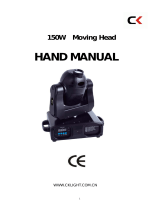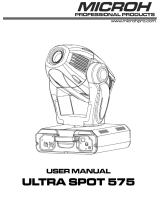Page is loading ...

1
Version 1.4

2
Table of contents
1. Safety instructions ........................................................................................................ 3
2.Operating determinations .............................................................................................. 4
3. Description of the device .............................................................................................. 5
4. Installation ...................................................................................................................... 6
4.1Fitting the lamp ........................................................................................................... 6
4.2 Lamp adjustment ....................................................................................................... 7
4.3 Inserting/Exchanging colours and gobos .................................................................... 7
4.4 Replacing the 3-facet prism........................................................................................ 8
4.5 Connection to the mains ............................................................................................. 9
4.6 Changing the power supply settings ........................................................................... 9
4.7 Rigging the fixture .................................................................................................... 10
4.8 DMX-512 connection/connection between fixtures.................................................... 12
4.9 Ethernet connection ................................................................................................. 13
5. DMX Protocol-version 1.0 ........................................................................................... 15
6. Controller mode ........................................................................................................... 21
6.1 DMX addressing ...................................................................................................... 21
6.2 Remotely controllable functions ................................................................................ 21
8.Control menu map ........................................................................................................ 23
9. Control menu ............................................................................................................... 27
9.1 Fixture Address ........................................................................................................ 27
8.2 Fixture informations .................................................................................................. 28
9.3 Personality ............................................................................................................... 29
9.4 Lamp On/Off ............................................................................................................ 30
9.5 Test sequences ........................................................................................................ 30
9.6 Manual mode ........................................................................................................... 30
9.7 Stand-alone setting .................................................................................................. 30
9.8 Reset functions ........................................................................................................ 31
9.9 Special functions ...................................................................................................... 32
10. Powerdown mode ...................................................................................................... 32
11. RDM ............................................................................................................................ 32
12. Error and information messages.............................................................................. 33
13. Technical specifications ........................................................................................... 35
14. Maintenance and cleaning ........................................................................................ 39
ColorSpot 575E AT

3
CAUTION!
Keep this device away from rain and moisture!
Unplug mains lead before opening the housing!
FOR YOUR OWN SAFETY, PLEASE READ THIS USER MANUAL CAREFULLY
BEFORE YOU INITIAL START - UP!
1. Safety instructions
Every person involved with installation and maintenance of this device have to:
- be qualilfied
- follow the instructions of this manual
CAUTION!
Be careful with your operations.
With a high voltage you can suffer
a dangerous electric shock when touching the wires!
This device has left our premises in absolutely perfect condition. In order to maintain this condition and to ensure
a safe operation, it is absolutely necessary for the user to follow the safety instructions and warning notes written
in this manual.
Important:
The manufacturer will not accept liability for any resulting damages caused by the non-observance of this manual
or any unauthorized modification to the device.
Please consider that damages caused by manual modifications to the device are not subject to warranty.
Never let the power-cord come into contact with other cables! Handle the power-cord and all connections with the
mains with particular caution!
Make sure that the available voltage is not higher than stated on the rear panel.
Always plug in the power plug least. Make sure that the power-switch is set to OFF-position before you connect
the device to the mains. The power-plug has to be accessable after installing the device.
Make sure that the power-cord is never crimped or damaged by sharp edges. Check the device and the power-
cord from time to time.
Always disconnect from the mains, when the device is not in use or before cleaning it. Only handle the power-cord
by the plug. Never pull out the plug by tugging the power-cord.
This device falls under protection class I. Therefore it is essential to connect the yellow/green conductor to earth.
The electric connection, repairs and servicing must be carried out by a qualified employee.
Do not connect this device to a dimmer pack.
Do not switch the fixture on and off in short intervals as this would reduce the lamp’s life.
During the initial start-up some smoke or smell may arise. This is a normal process and does not necessarily
mean that the device is defective.
Do not touch the device’s housing bare hands during its operation (housing becomes hot)!
For replacement use lamps and fuses of same type and rating only.
CAUTION ! EYEDAMAGES !
Avoid looking directly into the light source
(meant especially for epileptics) !

4
2.Operating determinations
This device is a moving-head spot for creating decorative effects and was designed for indoor use only.
If the device has been exposed to drastic temperature fluctuation (e.g. after transportation), do not switch it on
immediately. The arising condensation water might damage your device. Leave the device switched off until it has
reached room temperature.
Never run the device without lamp!
Do not shake the device. Avoid brute force when installing or operating the device.
Never lift the fixture by holding it at the projector-head, as the mechanics may be damaged. Always hold the
fixture at the transport handles.
When choosing the installation-spot, please make sure that the device is not exposed to extreme heat, moisture
or dust. There should not be any cables lying around. You endanger your own and the safety of others!
The minimum distance between light-output and the illuminated surface must be more than 2 meters.
Make sure that the area below the installation place is blocked when rigging, derigging or servicing the fixture.
Always fix the fixture with an appropriate safety-rope. Fix the safety-rope at the correct holes only.
Only operate the fixture after having checked that the housing is firmly closed and all screws are tightly fastened.
The lamp must never be ignited if the objective-lens or any housing-cover is open, as discharge lamps may
explose and emit a high ultraviolet radiation, which may cause burns.
The maximum ambient temperature 40°C must never be exceeded. Otherwise, the lamp is switched off and the
fixture is out of operation for 5 minutes.
CAUTION!
The lens has to be replaced when it is obviously damaged,
so that its function is impaired, e. g. due to cracks or deep scratches!
Operate the device only after having familiarized with its functions. Do not permit operation by persons not
qualified for operating the device. Most damages are the result of unprofessional operation!
CAUTION!
The lamp has to be replaced when it is damaged
or deformed due to the heat!
Please use the original packaging if the device is to be transported.
Please consider that unauthorized modifications on the device are forbidden due to safety reasons!
If this device will be operated in any way different to the one described in this manual, the product may suffer
damages and the guarantee becomes void. Furthermore, any other operation may lead to dangers like short-
circuit, burns, electric shock, burns due to ultraviolet radiation, lamp explosion, crash etc.

5
3. Description of the device
1 - Moving head
2 - Yoke
3 - Front panel
4 - Handle
Rear panel:
1 - 5-pin DMX output
2 - 5-pin DMX input
3 - 3-pin DMX output
4 - 3-pin DMX input
5 - Ethernet input
6 - Power switch
7 - Fuse holder-live
8 - Fuse holder-neutral
9 - Power cord
Front panel:
1 - Ethernet indicator
2 - Display
3 - Infra-red sensor
4 - Data transfer indicator
5 - RNS control wheel
6 - Escape button
7 - Enter button

6
4. Installation
4.1Fitting the lamp
DANGER !
Install the lamps with the device switched off only.
Unplug from mains before !
To insert the lamp MSR 575W/2 loosen the lamp cover at the rear of head (see the drawings ) by remowing the 3
fastening screws which are marked "X,Y,Z".Carefully pull out the cover with the lamp socket assembly.If changing
the lamp, remove the old lamp from the socket. Insert the lamp to the socket.
Do not install a lamp with a higher wattage! A lamp like this generates temperatures the device is not de-
signed for.Damages caused by non-observance are not subject to warranty. Please follow the lamp
manufacturer‘s notes!Do not touch the glass-bulb with bare hands during the installation! Make sure that the
lamp is installed tightly into the lampholder system.
Reclose the lamp cover and tighten the 3 screws.
Before striking the lamp, reset the "Lamp On Time"and "Lamp Strikes" counters in "Fixture information"
menu of the control board.
Do not operate this fixture with opened housing-cover!
3 fastening screws "X,Y,Z"
Lamp cover
Lamp cover

7
4.2 Lamp adjustment
The ColorSpot 575E AT lamp holder is aligned at the factory. Due to differences between lamps, fine adjustment
may improve light performance.
Strike the lamp,open the shutter and the iris,set the dimmer intensity onto 100% and focus the light on a flat
surface (wall).Center a hot-spot(the brightest part of the image) by using the 3 adjustment screws "A,B,C".Turn
one screw after another a quarter-turn clokwise(counter-clokwise) to set the hot-spot in the center of the image.If
you cannot detect the hot-spot,adjust the lamp until the light is evenly distributed.
4.3 Inserting/Exchanging colours and gobos
DANGER!
Install the colours gobos with the device switched off only.
Unplug from mains before!
If you wish to use other forms and patterns as the standard gobos, or if colours are to be exchanged, open the top
cover of the head by loosening 4 quarter-turn fasteners on the top cover.
Colour wheel:
Gently bend out the colour module to release it from the 3 distance slots and eject it from the pressing snap.
Put the new colour module back under the pressing snap and push it to the distance slots.
3 adjustment screws "A,B,C"
colour-module
pressing snap
distance slot

8
Stat.gobo wheel:
Gently bend out the gobo module to release it from the 3 distace slots and eject it from the pressing snap.
Put the new gobo module back under the pressing snap and push it to the distace slots.
Rotating gobo wheel:
Gently bend out the gobo module to release it from the distance slots and eject it from the pressing snap.
Press the ends of the fixation ring together with an appropriate tool and remove it from the gobo holder.Remove
the gobo and insert the new gobo. Press the ends of the fixation ring together and insert it in the front of the gobo.
Put the gobo module back under the pressing sn ap and push it to the distance slots.
CAUTION!
The gobo holder with the magnet must be placed in the same
position as it was placed before gobo replacement!
4.4 Replacing the 3-facet prism
Gently bend out the prism holder to release it from the fixative holes of prism module and eject it from the
pressing snap.
Put the new prism holder back under the pressing snap and push it to the 3 fixative holes.
distance slots
gobo module
pressing snap
distance slots
pressing snap
gobo module
gobo holder
gobo-glazy side
towards the lamp!
fixation ring
distance ring-
glazy side
towards the gobo!

9
4.5 Connection to the mains
Verify the power supply settings before applying power!
If you wish to change the power supply settings,see the chapter below.
Connect the fixture to the mains with the enclosed power plug.If you need to install other power plug on the power
cable,follow the identification table below.
The earth has to be connected!
Do not connect the fixture to a dimmer system!
The occupation of the connection-cables is as follows:
Cable (EU) Cable (US) Pin International
Brown Black Live L
Light blue White Neutral N
Yellow/Green Green Earth
4.6 Changing the power supply settings
Electronic ballast
The operating range of the electronic ballast is 90 VAC-250 VAC,50-60Hz.The transformer has to be set to the
local AC voltage.
If you want to change the power supply settings,follow the instructions:
1.Disconnect the fixture from AC power.
2.Remove the both top base covers by loosening the 12 screws.
3.Move the wire (3) on the transformer connection block to the position according to the desired voltage.
5.Close the base before applying AC power.
Example:
prism module
prism holder
pressing snap
fixative holes

10
4.7 Rigging the fixture
DANGER TO LIFE!
Please consider the respective national norms during the installation!
The installation must only be carried out by an authorized dealer!
The installation of the projector has to be built and constructed in a way that it can hold 10 times the weight for 1
hour without any harming deformation.
The installation must always be secured with a secondary safety attachment, e.g. an appropriate catch net. This
secondary safety attachment must be constructed in a way that no part of the installation can fall down if the main
attachment fails.
When rigging, derigging or servicing the fixture staying in the area below the installation place, on bridges, under
high working places and other endangered areas is forbidden.
The operator has to make sure that safety-relating and machine-technical installations are approved by an expert
before taking into operation for the first time and after changes before taking into operation another time.
The operator has to make sure that safety-relating and machine-technical installations are approved by an expert
after every four year in the course of an acceptance test.
The operator has to make sure that safety-relating and machine-technical installations are approved by a skilled
person once a year.
The projector should be installed outside areas where persons may walk by or be seated.
IMPORTANT! OVERHEAD RIGGING REQUIRES EXTENSIVE EXPERIENCE, including (but not limited to)
calculating working load limits, installation material being used, and periodic safety inspection of all installation
material and the projector. If you lack these qualifications, do not attempt the installation yourself, but instead use
a professional structural rigger. Improper installation can result in bodily injury and.or damage to property.
The projector has to be installed out of the reach of people.
If the projector shall be lowered from the ceiling or high joists, professional trussing systems have to be used. The
projector must never be fixed swinging freely in the room.
Caution: Projectors may cause severe injuries when crashing down! If you have doubts concerning the safety of
a possible installation, do NOT install the projector!
Before rigging make sure that the installation area can hold a minimum point load of 10 times the projector’s
weight.
Danger of fire !
When installing the device, make sure there is no highly inflammable
material (decoration articles, etc.) in between a distance of min. 0,7 m.
CAUTION!
Use 2 appropriate clamps to rig the fixture on the truss.
Follow the instructions mentioned at the bottom of the base.
Make sure that the device is fixed properly! Ensure that the structure (truss)
to which you are attaching the fixtures is secure.
The projector can be placed directly on the stage floor or rigged in any orientation on a truss without altering its
operation characteristics .

11
For overhead use, always install a safety-rope that can hold at least 10 times the weight of the fixture. You must
only use safety-ropes with screw-on carabines. Pull the safety-rope through the two apertures on the bottom of the
base and over the trussing system etc. Insert the end in the carabine and tighten the fixation screw.
Fixation via the omega holders
1.Bolt each clamp (1) to the omega holder (4) with M12 bolt and lock nut through the hole in the holder.
2.Fasten the omega holders on the bottom of the base by inserting both quick-lock fasteners (3) into the holes of
the base and tighten fully clockwise.
3.Fasten the safety-rope (2) through the two apertures on the bottom of the base and over the trussing system.
When installing fixtures side-by-side,
avoid illuminating one fixture with another!
DANGER TO LIFE!
Before taking into operation for the first time,the installation has to be approved
by an expert!
1-Clamp
2-Safety-rope
3-Quick-lock fastener
4-Omega holder

12
4.8 DMX-512 connection/connection between fixtures
The fixture is equipped with both 3-pin and 5-pin XLR sockets for DMX input and output.The sockets are wired in
parallel.
Only use a shielded twisted-pair cable designed for RS-485 and 3-pin or 5-pin XLR-plugs and connectors in order
to connect the controller with the fixture or one fixture with another.
DMX - output DMX-input
XLR mounting-sockets (rear view): XLR mounting-plugs (rear view):
If you are using the standard DMX controllers, you can connect the DMX output of the controller directly with the
DMX input of the first fixture in the DMX-chain. If you wish to connect DMX-controllers with other XLR-outputs,
you need to use adapter-cables.
Building a serial DMX-chain:
Connect the DMX-output of the first fixture in the DMX-chain with the DMX-input of the next fixture. Always
connect one output with the input of the next fixture until all fixtures are connected.
Caution: At the last fixture, the DMX-cable has to be terminated with a terminator. Solder a 120 Ω resistor
between Signal (–) and Signal (+) into a 3-pin XLR-plug and plug it in the DMX-output of the last fixture.
1 - Shield
2 - Signal (-)
3 - Signal (+)
4 - Not connected
5 - Not connected
1 - Shield
2 - Signal (-)
3 - Signal (+)
4 - Not connected
5 - Not connected

13
4.9 Ethernet connection
The fixtures on a data link are connected to the Ethernet with Art-Net communication protocol.The controlling
software from PC (or lighting console) has to support Art-Net protocol.
Art-Net communication protocol is a 10 Base T Ethernet protocol based on the TCP/IP.Its purpose is to allow
transfer of large amounts of DMX 512 data over a wide area using standard network technology.
IP address is the Internet protocol address.The IP uniquely identifies any node (fixture) on a network.
The Universe is a single DMX 512 frame of 512 channels.
The ColorSpot 575E AT is equipped with 8-pin RJ- 45 socket for Ethernet input.Use a network cable category 5
(with four "twisted" wire pairs) and standard RJ-45 plugs in order to connect the fixture to the network.
RJ-45 socket (front view): RJ-45 plug (front view):
1- TD+ 5- Not connected
2- TD- 6- RX-
3- RX+ 7- Not connected
4- Not connected 8- Not connected
Patch cables that connect fixtures to the hubs or LAN sockets are wired 1:1,that is,pins with the same numbers
are connected together:
1-1 2-2 3-3 4-4 5-5 6-6 7-7 8-8
If only the fixture and the computer are to be interconnected,no hubs or other active components are needed.A
cross-cable has to be used:
1-3 2-6 3-1 4-8 5-7 6-2 7-5 8-4
Ethernet connection
Connect the Ethernet-inputs of all fixtures in the fixture chain with the network.
Option " Ethernet" has to be selected from "Set Ethernet Mode" menu on the fixture.
Set IP address (002.xxx.xxx.xxx / 010.xxx.xxx.xxx) and the Universe.
Example:
(DMX address=49) (DMX address=25) (DMX address=1)
IP addres=002.168.002.004 IP addres=002.168.002.003 IP addres=002.168.002.002
Universe=1 Universe=1 Universe=1
An advised PC setting: IP address: 002.xxx.xxx.xxx / 010.xxx.xxx.xxx (Different from fixture IP addresses)
NET mask: 255.0.0.0

14
Ethernet / DMX connection
Options "Ethernet/DMX" has to be selected from "Set Ethernet Mode" menu on the first fixture (connected to the
network) in the fixture chain,next fixtures have standard DMX addresses.
Connect the Ethernet-input of the first fixture in the data chain with the network. Connect the DMX output of this
fixture with the input of the next fixture until all fixtures are connected to the DMX chain.
Caution: At the last fixture, the DMX chain has to be terminated with a terminator. Solder a 120
Ω resistor
between Signal (–) and Signal (+) into a XLR-plug and connect it in the DMX-output of the last fixture.
Example:
DMX address=73 DMX address=25 (DMX address=1)
IP addres=002.168.002.002
Universe=0
DMX address=217 DMX address=25 (DMX address=1)
IP addres=002.168.002.003
Universe=1

15
5.DMX Protocol-version 1.0
Mode/Channel Value Function Type of control
1 2 3 4
1 1 1 1 Pan
0-255 Pan movement by 530° proportional
2 2 2 2 Pan fine
0-255 Fine control of pan movement proportional
3 3 3 3 Tilt
0-255 Tilt movement by 280° proportional
4 4 4 4 Tilt fine
0-255 Fine control of tilt movement proportional
5 5 5 5 Pan/Tilt speed , Pan/Tilt time
0 Max.speed (tracking mode) step
P./T. speed- set Speed Mode in menu: P.t.Mo.
1-255 Speed from max. to min. (vector mode) proportional
P./T. time - set Time Mode in menu: P.t.Mo.
1-255 Time from 0.1s to 25.5s. * proportional
6 6 6 6 Power/Special functions
0-49 Reserved step
To activate following functions, stop in DMX value
for at least 3 s and shutter must be closed at least
3 s.("Shutter,Strobe" channel 25(18,27,20) must be
at range:0-31 DMX).**
50-59 Pan/Tilt speed mode step
60-69 Pan/Tilt time mode step
70-79 Blackout while pan/tilt moving step
80-89 Disabled blackout while pan/tilt moving step
90-99 Blackout while colour wheels moving step
100-109 Disabled blackout while colours wheel moving step
110-119 Blackout while gobo wheels moving step
120-129 Disabled blackout while gobo wheels moving step
To activate following functions, stop in DMX value
for at least 3 s.
130-139 Lamp On,reset(total reset except pan/tilt reset) step
140-149 Pan/Tilt reset step
150-159 Colour wheels reset step
160-169 Gobo wheels reset step
170-179 Dimmer/Strobe reset step
180-189 Focus/Zoom/Frost reset step
190-199 Iris/Prism reset step
200-209 Total reset step
210-229 Reserved step
230-239 Lamp Off step
240-255 Reserved step
7 7 Pan/Tilt macro selection
0-9 Disabled pan/tilt macro step
10-31 Reserved step
32-63 Figure of circle (from small to large) proportional
64-95 Figure of horizontal eight (from small to large) proportional
96-127 Figure of vertical eight (from small to large) proportional
128-159 Figure of rectangle (from small to large) proportional
160-191 Figure of triangle (from small to large) proportional
192-223 Figure of five-pointed star (from small to large) proportional
224-255 Figure of cross (from small to large) proportional

16
Mode/Channel Value Function Type of control
1 2 3 4
8 8 Pan/Tilt macro speed
Set pan/tilt speed (channel 5) to 0
0 No macro generation step
1-127 Macro generation from fast to slow -forwards proportional
128-129 No macro generation step
130-255 Macro generation from slow to fast- backwards proportional
7 7 9 9 Colour wheel1
Continual Positioning
In range 0-129 DMX is possible fine colour
positioning- set value on channel 8 (10)
0 Open/white proportional
13 Light blue proportional
26 Red proportional
39 Blue proportional
52 Light green proportional
65 Yellow proportional
78 Magenta proportional
91 Cyan proportional
104 Green proportional
117 Orange proportional
128-129 White proportional
Positioning
130-136 Light blue step
137-143 Red step
144-149 Blue step
150-156 Light green step
157-163 Yellow step
164-169 Magenta step
170-176 Cyan step
177-183 Green step
184-189 Orange step
190-215 Forwards rainbow effect from fast to slow proportional
216-217 No rotation step
218-243 Backwards rainbow effect from slow to fast proportional
244-249 Random colour selection by audio control step
(Set microphone sensitivity in menu "Personality")
250-255 Auto random colour selection from fast to slow proportional
8 10 Colour wheel 1-fine positioning
0-255 Fine positioning proportional
9 8 11 10 Colour wheel 2
Continual Positioning
In range 0 -129 DMX is possible fine colour
positioning- set value on channel 10(12)
0 Open/white proportional
14 Deep red proportional
28 Deep blue proportional
42 Pink proportional
56 Cyan proportional
70 Magenta proportional
84 Yellow proportional
98 3200K correction filter proportional
112 UV filter proportional
128-129 White proportional

17
Mode/Channel Value Function Type of control
1 2 3 4
Positioning
130-136 Deep red step
137-144 Deep blue step
145-151 Pink step
152-159 Cyan step
160-166 Magenta step
167-174 Yellow step
175-181 3200K correction filter step
182-189 UV filter step
190-215 Forwards rainbow effect from fast to slow proportional
216-217 No rotation step
218-243 Backwards rainbow effect from slow to fast proportional
244-249 Random colour selection by audio control step
(Set microphone sensitivity in menu "Personality")
250-255 Auto random colour selection from fast to slow proportional
10 12 Colour wheel 2-fine positioning
0-255 Fine positioning proportional
11 9 13 11 Static gobo wheel
Continual Positioning
In range 0-64 DMX is possible fine gobo
positioning- set value on channel 12(14)
0 Open/hole proportional
7 Gobo 1 (15010608) proportional
13 Gobo 2 (15010609) proportional
19 Gobo 3 (15010700) proportional
26 Gobo 4 (15010701) proportional
32 Gobo 5 (15010702) proportional
39 Gobo 6 (15010703) proportional
45 Gobo 7 (15010704) proportional
51 Gobo 8 (15010705) proportional
58 Gobo 9 (15010706) proportional
64 Open/hole proportional
Positioning
65-69 Gobo 1 step
70-74 Gobo 2 step
75-79 Gobo 3 step
80-84 Gobo 4 step
85-89 Gobo 5 step
90-94 Gobo 6 step
95-99 Gobo 7 step
100-104 Gobo 8 step
105-109 Gobo 9 step
Shaking gobos from slow to fast
110-119 Gobo 1 proportional
120-129 Gobo 2 proportional
130-139 Gobo 3 proportional
140-149 Gobo 4 proportional
150-159 Gobo 5 proportional
160-169 Gobo 6 proportional
170-179 Gobo 7 proportional
180-189 Gobo 8 proportional
190-199 Gobo 9 proportional
200-201 Open/hole
202-221 Forwards gobo wheel rotation from fast to slow proportional
222-223 No rotation
224-243 Backwards gobo wheel rotation from slow to fast proportional

18
Mode/Channel Value Function Type of control
1 2 3 4
244-249 Random gobo selection by audio control step
(Set microphone sensitivity in menu "Personality")
250-255 Auto random gobo selection from fast to slow proportional
12 14 Fine static gobo positioning
0-255 Fine positioning proportional
13 10 15 12 Rotating gobo wheel
Index - set indexing on channel 14 (11/16/13)
0-3 Open/hole step
4-7 Gobo 1 (15030017) step
8-11 Gobo 2 (15040011) step
12-15 Gobo 3 (15020149) step
16-19 Gobo 4 (15020150) step
20-23 Gobo 5 (15020151) step
24-27 Gobo 6 (15020152) step
28-31 Gobo 7 (15020153) step
Rotation - set rotation on channel 14 (11/16/13)
32-35 Gobo 1 step
36-39 Gobo 2 step
40-43 Gobo 3 step
44-47 Gobo 4 step
48-51 Gobo 5 step
52-55 Gobo 6 step
56-59 Gobo 7 step
Shaking gobos from slow to fast
Index - set indexing on channel 14 (11/16/13)
60-69 Gobo 1 proportional
70-79 Gobo 2 proportional
80-89 Gobo 3 proportional
90-99 Gobo 4 proportional
100-109 Gobo 5 proportional
110-119 Gobo 6 proportional
120-129 Gobo 7 proportional
Shaking gobos from slow to fast
Rotation - set rotation on channel 14 (11/16/13)
130-139 Gobo 1 proportional
140-149 Gobo 2 proportional
150-159 Gobo 3 proportional
160-169 Gobo 4 proportional
170-179 Gobo 5 proportional
180-189 Gobo 6 proportional
190-199 Gobo 7 proportional
200-201 Open/hole step
202-221 Forwards gobo wheel rotation from fast to slow proportional
222-223 No rotation
224-243 Backwards gobo wheel rotation from slow to fast proportional
244-249 Random gobo selection by audio control step
(Set microphone sensitivity in menu "Personality")
250-255 Auto random gobo selection from fast to slow proportional
14 11 16 13 Gobo indexing and rotation
Gobo indexing
0-255 Gobo indexing proportional
Gobo rotation
0 No rotation step
1-127 Forwards gobo rotation from fast to slow proportional
128-129 No rotation step
130-255 Backwards gobo rotation from slow to fast proportional

19
Mode/Channel Value Function Type of control
1 2 3 4
15 17 Gobo fine indexing
0-255 Fine indexing proportional
16 12 18 14 Prism
0-19 Open position (hole) step
20-127 3-facet rotating prism step
128-255 Prism/gobo macros step
128-135 Macro 1 step
136-143 Macro 2 step
144-151 Macro 3 step
152-159 Macro 4 step
160-167 Macro 5 step
168-175 Macro 6 step
176-183 Macro 7 step
184-191 Macro 8 step
192-199 Macro 9 step
200-207 Macro 10 step
208-215 Macro 11 step
216-223 Macro 12 step
224-231 Macro 13 step
232-239 Macro 14 step
240-247 Macro 15 step
248-255 Macro 16 step
17 13 19 15 Prism rotation
0 No rotation step
1-127 Forwards rotation from fast to slow proportional
128-129 No rotation step
130-255 Backwards rotation from slow to fast proportional
18 14 20 16 Frost
0 Open step
1-179 Frost from 0% to 100% proportional
180-189 100% frost proportional
190-211 Pulse closing from slow to fast proportional
212-233 Pulse opening from fast to slow proportional
234-255 Ramping from fast to slow proportional
19 21 Frost fine
0-255 Fine frost proportional
20 15 22 17 Iris
0 Open step
1-179 From max.diameter to min.diameter proportional
180-191 Closed step
Pulse effects with Iris blackout
192-219 Pulse opening from slow to fast proportional
220-247 Pulse closing from fast to slow proportional
248-249 Random pulse opening (fast) step
250-251 Random pulse opening (slow) step
252-253 Random pulse closing (fast) step
254-255 Random pulse closing (slow) step
21 23 Iris fine
0-255 Iris fine proportional

20
Mode/Channel Value Function Type of control
1 2 3 4
22 16 24 18 Zoom
Zoom without focus corection
0-39 Zoom 15° step
40-79 Zoom 18° step
80-127 Zoom 22° step
Zoom with focus corection ***
128-169 Zoom 15° step
170-219 Zoom 18° step
220-255 Zoom 22° step
23 17 25 19 Focus
0-255 Coarse focus proportional
24 26 Focus fine
0-255 Fine focus adjustment
25 18 27 20 Shutter,Strobe
0-31 Shutter closed,Lamp power reduced after 10s to 400W step
32-63 Shutter open ,Full lamp power step
64-95 Strobe-effect from slow to fast(max.15 flashes/s) proportional
96-127 Shutter open,Lamp power reduced to 400 W step
128-143 Opening pulse in sequences from slow to fast proportional
144-159 Closing pulse in sequences from fast to slow proportional
160-191 Shutter open,Electronic strobing"ZAP" from slow
to fast (from 7 to 33 flashes/s) proportional
192-223 Random strobe-effect from slow to fast proportional
224-255 Shutter open,Full lamp power step
26 19 28 21 Dimmer
0-255 Dimmer intensity from 0% to 100%, proportional
(In range 0-8 DMX,lamp power reduced to 400 W
after 10 s)
27 29 Dimmer fine
0-255 Dimmer intensity fine proportional
* Short times are not used for long tracks( e.g. 0.5s for track 0-255 DMX).Times are restricted by
mechanical parameters of the fixture.
** The switch-functions have priority to the equivalent functions in menu "Personality"but the setting
by DMX is not saved to the memory( after switching the fixture on,the setting from menu "Personality"
is loaded and after that can be changed by DMX value on the channel 6).
DMX protocol menu "Personality"
50-59 Pan/Tilt speed mode Pan/Tilt mode—>Speed Mode
60-69 Pan/Tilt time mode Pan/Tilt mode—>Time Mode
70-79 Blackout while pan/tilt moving Active blackout While—>Pan/Tilt Moving—>On
80-89 Disabled blackout while pan/tilt moving Active blackout While—>Pan/Tilt Moving—>Off
90-99 Blackout while colour wheels moving Active blackout While—>Colour Wheels Moving—>On
100-109 Disabled blackout while col. wheels mov. Active blackout While—>Colour Wheels Moving—>Off
110-119 Blackout while gobo wheels moving Active blackout While—>Gobo Wheels Moving—>On
120-129 Disabled blackout while gobo wheels moving Active blackout While—>Gobo Wheels Moving—>Off
*** The function improves the image on the wall if the zoom changes(its effect is the best for gobos from rot.
gobo wheel and for distance = 6 m)
/






